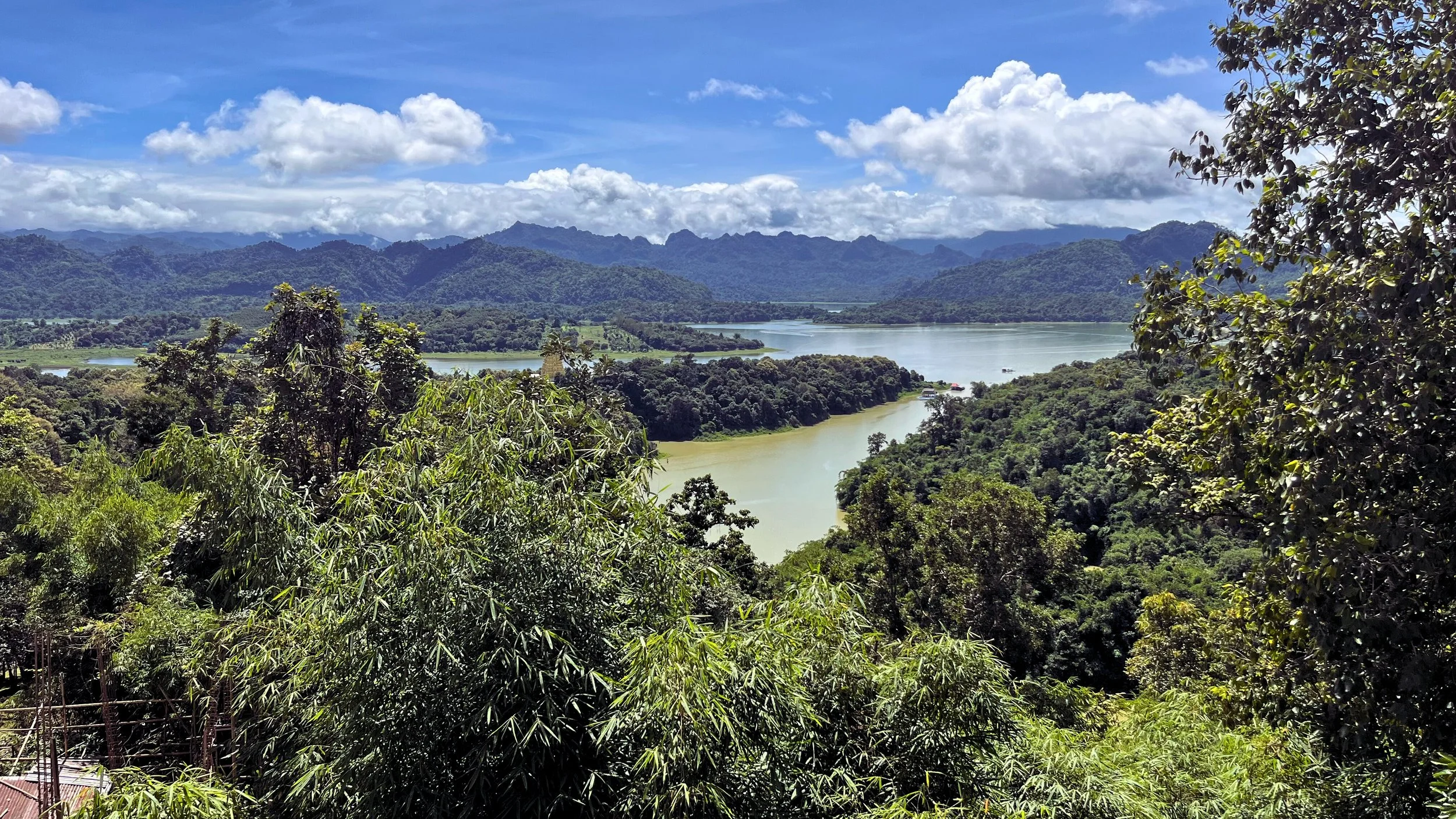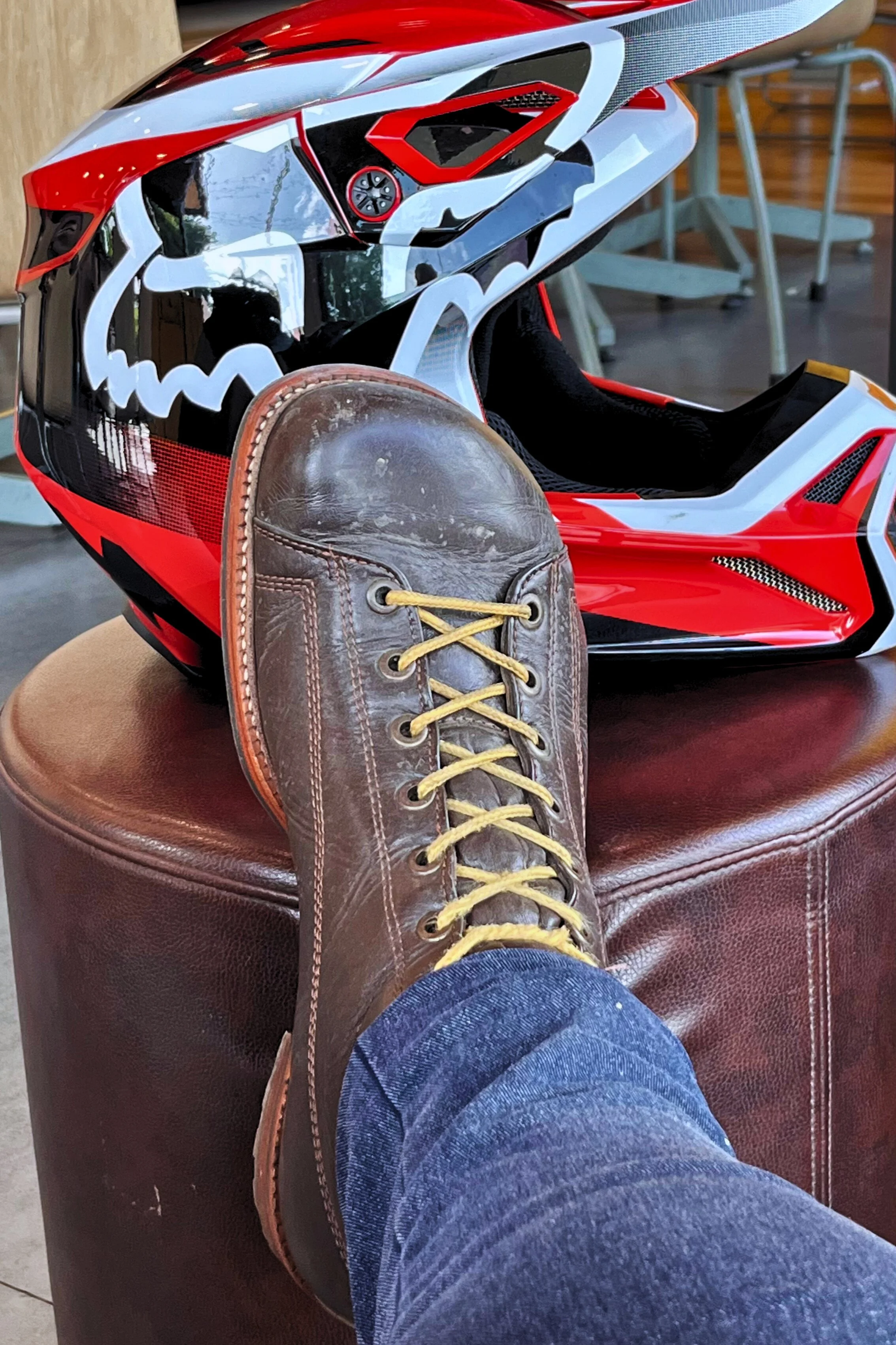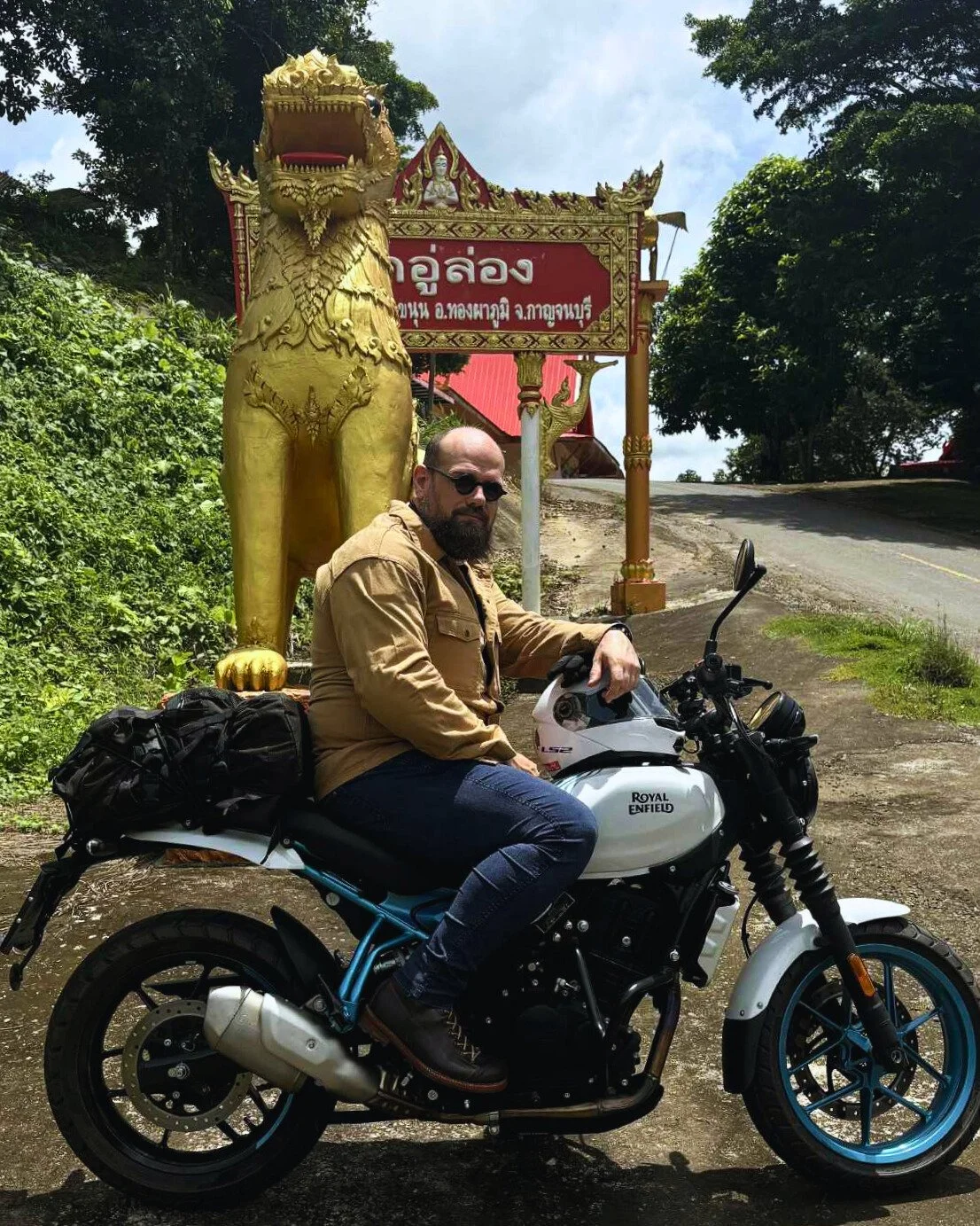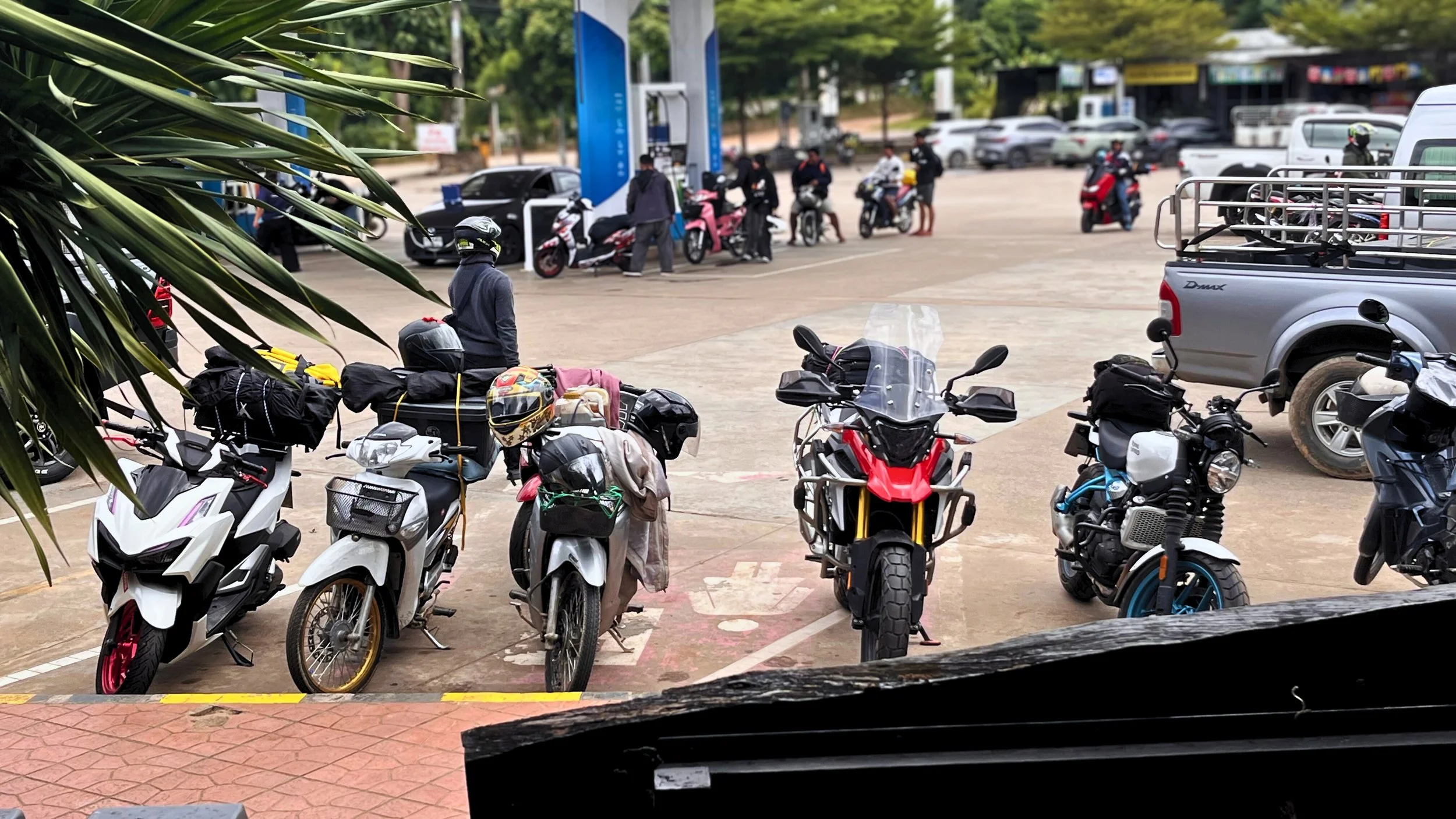Riding the Borderlands: Dust, History, and the Three Pagodas Pass
There are rides you plan, and rides that just happen. This was one of the planned ones, but even the best plans don’t prepare you for what the road gives back. The Three Pagodas Pass had been on my list for a while, a route stacked with history, grit, and the kind of roads that test both machine and rider. The rainy season had finally eased. In Thailand, you learn to respect the rain. Out here, a storm doesn’t just get you wet; it can pin you down on the roadside, staring at sheets of water that make the world disappear. This was our shot to slip through dry and chase the borderlands with my friend Sidth, a man who can turn any ride into an adventure worth remembering.
Sidth and I on the way up to the Three Pagodas Pass
Breaking Free of Bangkok
Sidth rolled up to my place an hour before sunrise. Bangkok was still half-asleep, but the heat was already pushing its way through the night air. I could feel it inside my jacket, sweat before the first turn of the throttle. We wanted out of the city before traffic started stacking up, before the exhaust haze swallowed the skyline. Out there, with the highway open and the air moving past us, the heat would break, replaced by that cool rush that only comes when you’re chasing dawn on two wheels.
Riding with Sidth is always its own kind of adventure. He’s the guy who knows the backdoors out of town, the dirt cut-throughs that make you feel like you’re stealing miles from the map. He’ll pull you into a roadside coffee shack that looks like nothing, then hand you the best cup you’ve had in weeks. Every food stop is a lesson, bowls of noodles, grilled skewers, flavors that knock you awake better than any caffeine. With him, the ride is never just about the distance; it’s about everything that happens between the miles. And with luck, breakfast would be our first checkpoint.
You don’t need to get far out of Bangkok to be in nature.
Leaving The City Behind
We pushed west, chasing the fading shadows as the sun came up behind us. Within an hour, Bangkok’s grip started to loosen, the skyline shrinking in the mirrors, the sound of horns and scooters giving way to open stretches of asphalt. There was a shift you could almost taste. The air grew cleaner, cooler, carrying the scent of farmland instead of smog. After weeks of city grind, that first breath of fresh country air felt like it rinsed your lungs.
By the time we hit Nakhon Pathom, the sprawl had thinned into wide fields and long straights. Towns grew smaller, farther apart. The kind of roads that let you stretch the gears and feel the bike breathing under you. Just shy of two hours in, Sidth raised a hand, signaling a turn. True to form, he peeled off onto a dirt and gravel lane that most riders would’ve blown past without a second glance. A couple minutes later, we rolled into a little village square, our first checkpoint of the day.
Front and center was a humble noodle shop, steam fogging its windows. Next door, a no-frills coffee stand, metal cups stacked high, and the smell of burnt beans cutting through the morning air. Gourmet? Not even close. But it was hot, strong, and exactly what we needed.
The duck noodles landed heavy and perfect. I went all in, extra blood cake, a splash of vinegar, a heavy hand of dried chili. The kind of bowl that wakes you up from the inside out, fatty broth cut sharp with heat. Breakfast like that sticks with you, the kind you’re still thinking about miles later.
On this trip, both Sidth and I were wearing prototypes of the Naang Winnfield. Originally built with rucking and hiking in mind, but like every boot we make, overbuilt enough to take whatever you throw at them, including motorcycle miles. I’d been breaking mine in for months. By now, they were molded to me, moving as one with every shift of the footpeg. Boots you can trust to carry you through the long haul, whether it’s dirt trails, border roads, or back alleys of Bangkok.
We lingered a while, sipping thick coffee and tracing the route ahead. Kanchanaburi was next, the farmland giving way to hills, the roads starting to climb, the ride about to show us what it really had in store.
The Road to Kanchanaburi
With breakfast settling in our guts, we were back in the saddle, pushing northwest into Kanchanaburi. The roads stretched long and straight, wide enough to let the throttle breathe. Out here, you can give the bike a little more than she needs, feel the engine climb, the wind cut clean past your helmet. But those straights never last. By the time we were knocking on the door of Erawan National Park, the lines began to bend. The road lifted under us, curves stitched into the hills, and the smooth pavement started to shrink into something tighter, more demanding.
I’d ridden this stretch before, and I knew what was coming. Once you slip past the park boundaries, “rural” isn’t the right word anymore; it’s rough, forgotten, patched in places where trucks chew the surface down to gravel. But that’s when the ride starts to get interesting. The road narrows to two lanes, twisting harder, trucks lumbering around blind corners with their loads swaying. You learn to ride with patience and precision, every pass a calculation, every blind curve a gamble. Lucky for us, the duck noodles and strong coffee were still running through our veins.
There’s a weight to these roads that you feel if you know the history. During the Second World War, this stretch of jungle saw some of Thailand’s darkest days. The Japanese army carved the “Death Railway” through here with forced labor, tens of thousands of POWs and conscripts broken against the heat, the sickness, the brutality. Their ghosts ride these hills with you, and if you listen close enough, you can still feel the echo.
Just about halfway there.
But even in that shadow, seeds were planted. The boots that came to Thailand with soldiers were the sparks that eventually grew into Thailand’s own quiet tradition of bootmaking. Hard history, yes, but it shaped the soil we’re still walking on.
Past the park gates, Sidth threw me a look, half grin, half dare, and cut hard right, off the main road. We dropped onto an old fire road, the kind of track most riders miss unless they’ve got a guide who knows where to look. The pace slowed, but the fun doubled. Dirt under the wheels, trees pressing in, the lake flashing through breaks in the brush. Every few minutes, we’d crest a rise and catch a view that felt stolen, mountains folded into each other, water shimmering in the valleys, nothing but the hum of the bikes and the crunch of gravel.
This is why riding in Thailand gets under your skin. It’s not just the highways or the passes, it’s the hidden cuts, the forgotten fire roads, the places you only find when you’re chasing lines with someone who knows them like old friends. Out here, the ride becomes more than the sum of its parts.
Three Pagodas Pass arrival
After our detour on the fire road, the Three Pagodas Pass was just a few hours ahead. One more stop for fuel and food before the final push. Thong Pha Phum gave us both a quick top-up at the pumps and a roadside lunch that couldn’t have been simpler: a handful of grilled chicken skewers, a serving of sticky rice. No coffee this time, just smoke from the grill and the salty-sweet bite of charred chicken. In Thailand, that’s all you need to keep rolling.
Our Last Fuel Stop Before The Three Pagodas Pass
From there, the road showed its teeth. The asphalt gave way to something rougher, worn down by trucks and rain. The elevation began to swing, climbing, dropping, twisting into hairpins and switchbacks that kept us pinned to the bikes. Every corner demanded focus, every straight was short and narrow. It was sketchy, sure, but this was the kind of riding that keeps you awake and alive, the kind that reminds you you’re not out here for easy miles.
The higher we climbed, the cooler the air became. Gone was the heavy Bangkok humidity, replaced with a crispness that cut into our lungs and kept our heads sharp. The road clung to the side of the mountain, rock face pressing close on one side, a sheer drop yawning on the other. For hours, we threaded that line, locked into a single path with no way out. Wrecked trucks lay abandoned in the ditches, a reminder of what happens when you misjudge the balance between speed and gravity.
And then, just like that, the mountains opened their grip. A short straight stretch appeared, and within a few hundred meters, we were rolling into the border itself, pulling up at the base of the Three Pagodas.
Not long ago, this crossing was a lifeline, a way to cut through Myanmar and reach the remote northern provinces of Thailand. During the war, after the Japanese carved the Death Railway through this land, the pass became a key trade route between the two countries. But not today. Myanmar is locked in a civil war, and the border is sealed tight. The last time I’d ridden close to this frontier, I heard gunfire rolling over the hills. This time, there was only silence, the gates shut, movement frozen.
There’s a weight in standing there, knowing we can move freely, but just across the line, others are trapped by conflict. The Three Pagodas have stood through centuries of history, trade, invasion, war, and uneasy peace, and now they mark a border no one can cross.
We parked the bikes, walked the grounds, and found a small outdoor coffee stand. Sitting in the shade with a cup in hand, we let the road sink in, the heat, the climbs, the history under our wheels. The trip wasn’t over, but this was a moment to pause and take stock. Rides like this aren’t about racing to the end; they’re about the weight of the miles, the stories carried in the land, and the way it all settles in your chest when the throttle goes quiet.
Reflections at Elevation
That night we found a small lakeside hotel, the kind of place that doesn’t advertise, just waits quietly for whoever stumbles in. The rooms were simple, but the view was priceless, water stretched out flat and dark, reflecting the last streaks of sunset. We ate dinner right on the shore, plates of fiery somtam and grilled fish laid out in front of us, the sound of the lake lapping against the dock filling the silence between bites.
Over dinner, the ride replayed itself in our heads. The early start in Bangkok, the noodle shop detour, the fire road, the mountain switchbacks, the weight of the border. Trips like this have a way of stripping things down. Out there, the clutter of daily life falls away and you’re left with the essentials, your machine, the road, the friend riding beside you. Everything else is noise.
Sidth and I sat back in our chairs, bellies full, bodies sore, boots kicked out under the table. The Winnfields on my feet were caked in dust and gravel, scarred by shifter and peg, but they felt like part of me now, worn in, broken to the shape of the ride itself. It’s the same lesson the road teaches again and again: good things take time, the miles matter, and the hard way is the only way that lasts.
Perspective doesn’t come in comfort. It comes in sweat, in grit, in roads that demand your focus and meals shared at the end of the day with someone who understands why you chase them. The lake was calm, the night was quiet, and for the first time all day, the throttle was still. Tomorrow the road would call again. It always does.
















